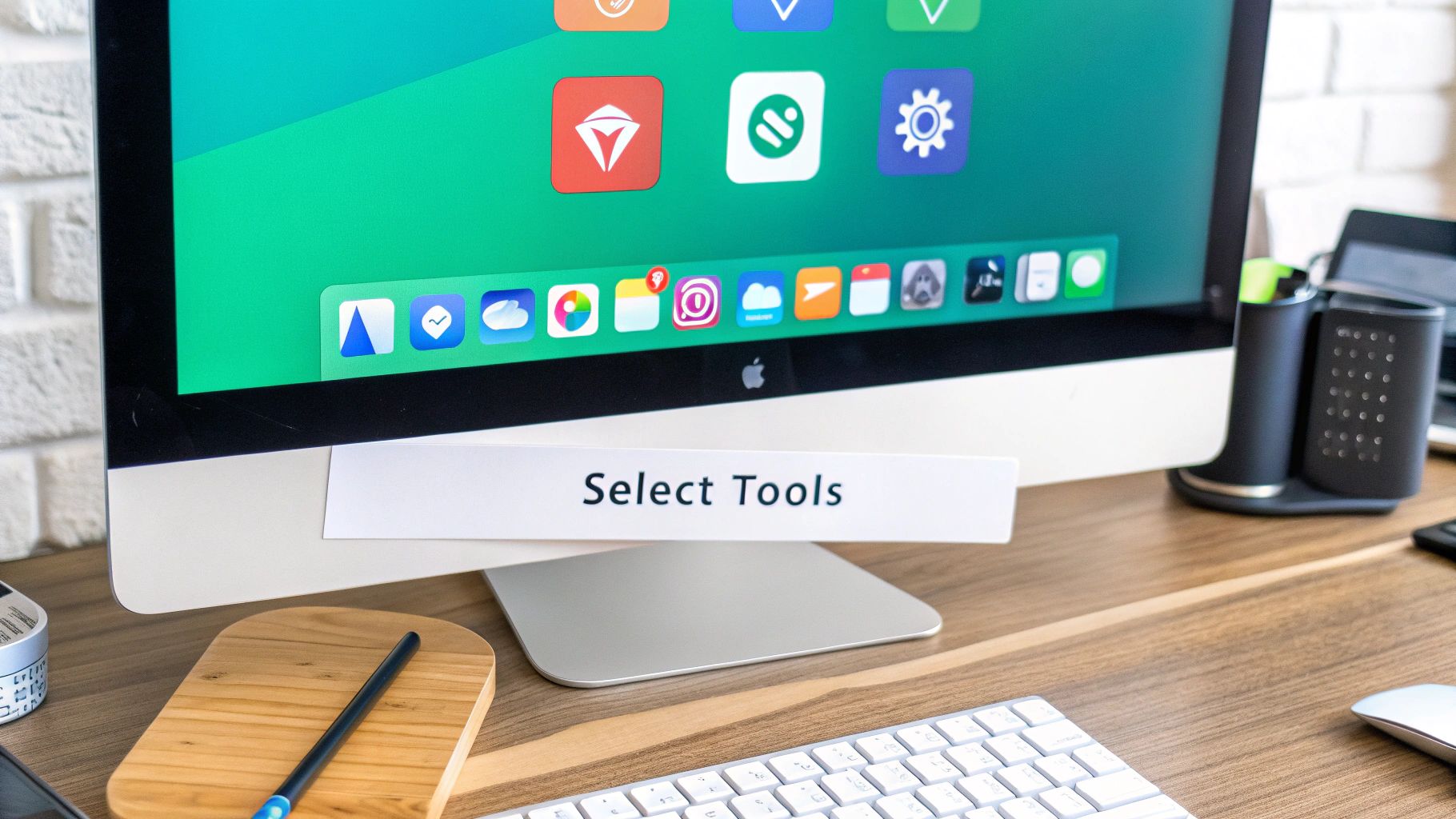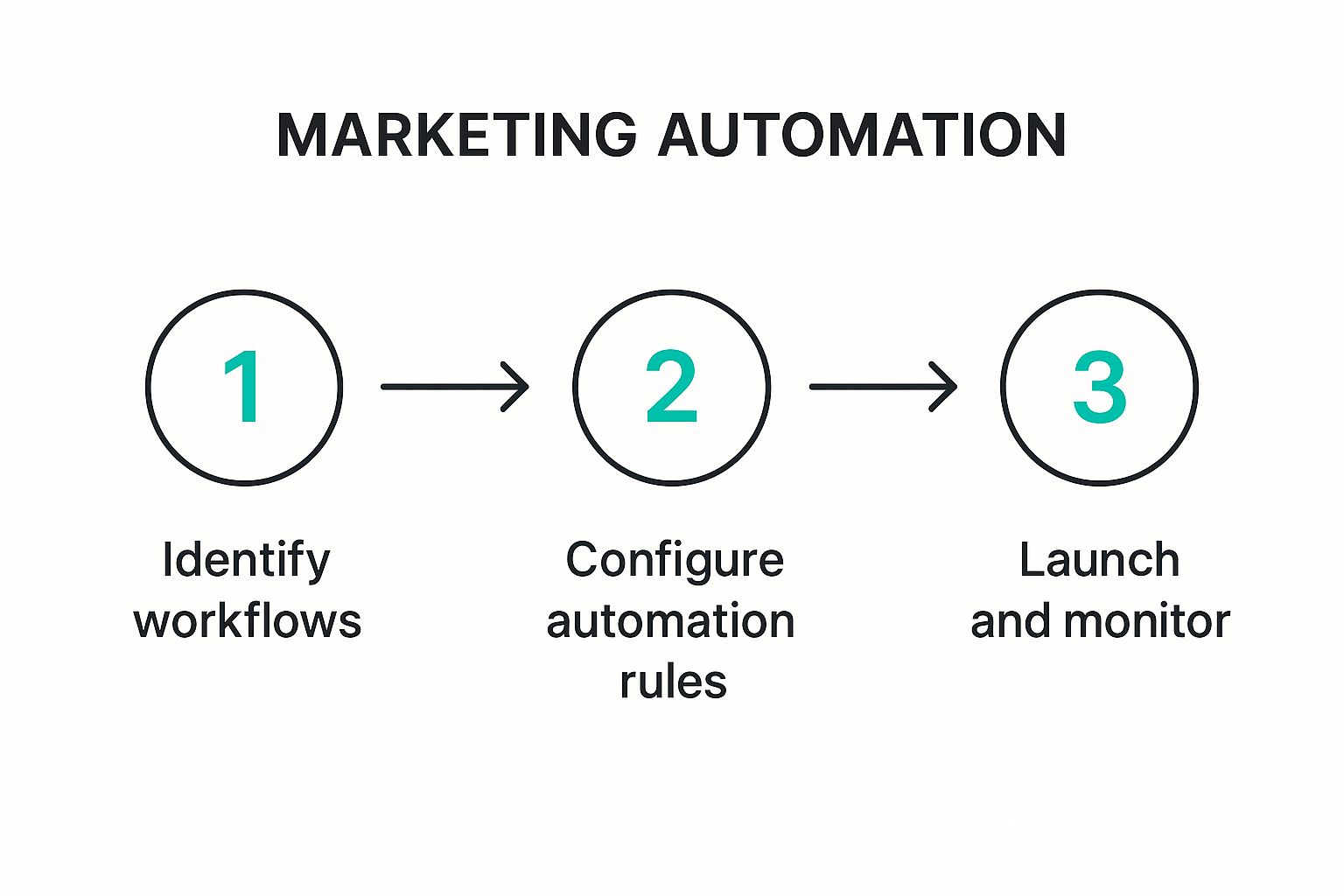Small Business Marketing Automation That Actually Works
If you’re running a small business, you know that time is your most precious resource. Marketing automation is simply using software to take repetitive marketing tasks off your plate, freeing you up to focus on growing your business. It's how you can automatically nurture leads, personalize customer communication, and track campaign performance without having to do it all by hand.
Think of it as leveling the playing field, giving you the same firepower as your larger competitors.
Why Automation Is a Game-Changer for Small Business

There’s an old myth that marketing automation is only for big corporations with bottomless budgets. That’s just not true anymore. Today, it’s the great equalizer, giving small businesses the power to operate with the efficiency and precision of a much larger team. The real win here isn't just about fancy technology; it's about getting your time back.
When you automate the routine stuff—like manual email sends, daily social media posts, and tedious lead data entry—you're no longer stuck in the daily grind. This is a huge shift. It lets you step back and focus on strategy, creative ideas, and building real customer relationships. You know, the things that actually drive sustainable growth.
More Than Just Saving Time
While clawing back hours in your day is a massive plus, the true impact of marketing automation runs much deeper. It empowers you to create sophisticated, personalized experiences that build lasting loyalty. Imagine having a system that works for you 24/7, nurturing leads and engaging customers even when you’re not at your desk.
This unlocks tangible benefits that go straight to your bottom line:
- Higher Conversion Rates: By sending the right message to the right person at the right time, you guide potential customers through their buying journey much more effectively.
- Improved Customer Retention: Automated follow-ups, personalized recommendations, and timely check-ins make your customers feel seen and valued, which keeps them coming back.
- Data-Driven Decisions: Instead of guessing what’s working, automation platforms give you clear analytics on campaign performance, helping you put your money where it counts.
A Growing Market for a Reason
The explosive growth in this space tells you everything you need to know. The marketing automation market is on track to jump from $5.65 billion in 2024 to $14.55 billion by 2031. This isn't just a fluke; it's fueled by small businesses realizing that automation is no longer a "nice-to-have"—it's a core part of a modern marketing strategy.
In fact, decision-makers are reporting a 91% increase in demand for these solutions. You can check out more stats and insights on marketing automation's growth on SuperAGI.com.
Automation gives you the power to do more with less. It's not about replacing the human touch; it's about amplifying it by handling the repetitive work, so you can focus on meaningful interactions.
Ultimately, marketing automation isn't just another tool to add to your collection. When you put it to work thoughtfully, it becomes the engine that powers your growth. It helps you compete, scale, and build a stronger, more resilient business.
Setting the Stage for Automation Success

It’s tempting to get swept up in the promise of new software, but diving straight into a tool is one of the biggest mistakes I see small businesses make with marketing automation. Real success isn't about the platform you pick; it's about the plan you build first.
Without a clear strategy, even the most powerful software ends up being just another expensive subscription gathering dust. This foundational work is what separates automation that feels genuinely helpful from the kind that comes off as robotic and annoying. Before you even think about comparing features, you need to look inward and figure out what you’re actually trying to accomplish.
Define Your Primary Automation Goals
Let’s start with a simple question: "What problem am I trying to solve?" The answer is going to be different for everyone. Maybe you're drowning in new leads and can't keep up. Or perhaps your biggest headache is getting existing customers to come back for more.
Your goals have to be specific. "Improve marketing" is too vague to be useful. You need tangible outcomes you can actually measure.
- Generate More Qualified Leads: Your goal might be to automate the initial follow-up so you can qualify leads faster, letting your sales team focus their energy on people who are ready to talk.
- Improve the Onboarding Experience: You could create a welcome email series that walks new customers through your product, cutting down on support tickets and making them feel valued from day one.
- Drive Repeat Business: An objective could be to automatically send a follow-up email with a special offer 30 days after a purchase, nudging them toward another sale.
Your marketing automation goals are your North Star. They dictate which tasks to automate, what content to create, and how you'll measure whether any of this is actually working. Without them, you’re just automating for the sake of it.
Identify Your Biggest Time Sinks
Once your goals are clear, it's time to audit what you’re already doing. Grab a notepad (or open a spreadsheet) and list every single repetitive marketing task that you or your team handles on a daily or weekly basis. This is where you’ll find your golden opportunities.
Think about stuff like:
- Manually sending a welcome email to every single new subscriber.
- Copying and pasting lead info from a website form into your CRM.
- Posting the same updates across three different social media channels, one by one.
Each of these manual chores is a perfect candidate for an automated workflow. Start with the ones that eat up the most time or are the most prone to human error. Automating just one of these can give you back hours every single week.
Map Your Customer Journey
For your automation to truly hit the mark, you have to understand the path your customers take—from the first time they hear about you to the moment they become a loyal fan. This is called customer journey mapping, and it helps you pinpoint the exact moments where an automated message can make the biggest impact.
For a service-based business, a simple journey map might look something like this:
- Awareness: A potential client finds one of your blog posts through a Google search.
- Consideration: They download a free checklist from your site, giving you their email.
- Conversion: After getting a few helpful, non-salesy emails, they book a consultation call.
- Loyalty: After you’ve delivered the service, they get an automated request for a review.
When you visualize this path, you can design workflows that meet people where they are. That person who downloaded the checklist? They're clearly interested but probably not ready for a hard sell. A pushy sales email would just turn them off. But a series of automated emails that offer more value and build trust? That’s the sweet spot.
This strategic approach is the bedrock of a solid lead generation system. To go deeper on this, check out our beginner's guide to B2B lead generation for more ideas.
Finding the Right Automation Tools Without Overspending

The market for marketing automation software is crowded, to say the least. It’s easy to get overwhelmed and think you need a massive, enterprise-level platform to see any real results.
Good news: you don't. You can get powerful automation working for your business without a monster budget. The trick is knowing what to look for and, just as importantly, what to ignore.
The biggest mistake I see small businesses make is getting distracted by flashy features they won't use for another two years. That’s a surefire way to overspend and end up with a system that's way too complicated. Focus on tools that solve your immediate problems and can grow with you.
Core Features You Actually Need
When you're just starting, your automation tool needs to be a workhorse, not a show horse. Your goal is to prioritize a handful of essential features that will make the biggest difference in your day-to-day marketing.
Here’s what I consider non-negotiable for a starter toolkit:
- An Intuitive Workflow Builder: This is the heart of any automation platform. You need a visual, drag-and-drop interface that makes building sequences easy, no coding required. If it looks like a rocket ship dashboard, run.
- Simple Lead Capture Forms: You have to get new contacts into your system somehow. The tool should make it dead simple to create and embed forms on your website or landing pages.
- A Flexible Email Builder: Your automated emails still need to look sharp and on-brand. A good tool offers clean templates and an editor that doesn't feel like you're fighting with it to create personalized messages.
- CRM Integration: This one is critical. Your marketing automation tool has to talk to your Customer Relationship Management (CRM) system. This keeps all your lead data, engagement history, and sales activities in one place, giving you a complete picture of your customer.
This foundation is more than enough to build the high-impact workflows you need right now—think welcome series, lead nurturing sequences, and customer onboarding campaigns. Don't sweat the advanced stuff like predictive analytics or AI-powered send times for now. You can always level up later.
Understanding Different Pricing Models
This is where things can get confusing fast. Most platforms use one of two main models, and knowing the difference will save you from surprise bills as you grow.
- Per-Contact Pricing: You pay based on how many contacts are in your database. It’s straightforward, but costs can jump quickly as you build your email list.
- Tiered-Feature Pricing: You pay for access to different feature sets. A basic tier might only cover email blasts, while a premium tier unlocks the cool automation workflows and CRM integrations.
My advice? Look for a tool that offers a balanced mix. The sweet spot for a growing business is often a platform with a generous contact limit on its entry-level plan that still includes the core automation features. This lets you grow your audience without getting pushed into an expensive upgrade right away.
Comparing Popular Automation Tools for Small Businesses
To help you cut through the noise, it's useful to see how some of the most popular small-business-friendly platforms stack up against each other. The market is definitely shifting to serve smaller companies better, which is great news for all of us.
In fact, small and medium-sized businesses are adopting these tools faster than anyone, with a projected compound annual growth rate of 15.2% through 2030. This boom is largely thanks to accessible SaaS tools from companies like ActiveCampaign and Mailchimp. You can dig into more of these stats over on Inbeat.agency.
Here's a quick comparison to help you see where different tools shine.
Comparing Popular Automation Tools for Small Businesses
| Tool | Best For | Core Features | Pricing Model |
|---|---|---|---|
| Intently | Solopreneurs and teams needing high-intent leads from social channels | AI-driven social listening, real-time lead alerts, intent signal detection | Credit-based and tiered plans for scalability |
| Mailchimp | Beginners and businesses focused primarily on email marketing | User-friendly email builder, basic automation templates, landing pages | Combination of per-contact and tiered features |
| ActiveCampaign | Businesses wanting powerful automation and CRM in one platform | Advanced workflow builder, lead scoring, integrated sales CRM | Per-contact and tiered features |
| ConvertKit | Content creators, bloggers, and course creators | Simple email funnels, subscriber tagging, easy form and landing page creation | Per-contact and tiered features |
Ultimately, the best tool is the one that fits your specific goals and feels right for you and your team. Don't just read a feature list. Sign up for a few free trials and see which one you actually enjoy using. You're choosing a partner for growth, not just buying a piece of software.
Your First High-Impact Automation Workflows
Alright, you've got your goals mapped out and your tools ready to go. Now for the fun part: building your first automated campaigns.
The secret here is to start with a few high-impact workflows. We're looking for the ones that will deliver immediate value, save you a ton of time, and make your customer experience better from day one. Don't try to automate everything at once. Just focus on these proven sequences first.
Think of these as flexible blueprints. You can tweak the timing, the content, and the specific actions to fit your business perfectly. The whole point is to create automated touchpoints that feel personal, timely, and genuinely helpful.
This simple flow chart really breaks down how to get started: nail down your key workflows, set up the rules in your software, then launch and watch them work.

This shows that successful marketing automation for a small business isn't magic; it just follows a clear, repeatable path.
The Essential Welcome Series
Your welcome series is your chance to make a killer first impression. When someone subscribes to your list, they are at their absolute peak level of interest. A strong welcome sequence grabs that attention, tells your brand's story, and lets them know what to expect from you.
This is way more than a single "thanks for subscribing" email. A great welcome series is usually a sequence of three to five emails sent over the first week.
Real-World Example: A Boutique Coffee Roaster
Let's say you run a small-batch coffee roasting company. Someone signs up for your newsletter to get a 10% discount on their first order. Here’s what their welcome journey could look like:
- Email 1 (Sent Immediately):
- Trigger: New subscriber joins the "Newsletter" list.
- Action: Send an email with a subject like, "Welcome to the Club! Here's Your 10% Off." The email delivers the discount code, thanks them for joining, and briefly shares your mission of sourcing ethical beans.
- Email 2 (Wait 2 Days):
- Trigger: Two days pass after Email 1.
- Action: Send an email titled, "Our Story in Three Sips." This one tells the founder's story, maybe includes a photo of the roasting team, and links to your "About Us" page. It's all about building that human connection.
- Email 3 (Wait 3 Days):
- Trigger: Three days pass after Email 2.
- Action: Send an email showcasing your best-selling blends. The subject could be, "Not Sure Where to Start? Here Are Our Fan Favorites." This helps new subscribers get over choice paralysis and points them toward your most popular products.
This simple three-part series does so much more than just hand out a coupon. It builds a relationship, educates the new subscriber, and gently guides them toward that first purchase.
The Proactive Lead Nurturing Workflow
Let's be real: not everyone who shows interest is ready to buy right away. Lead nurturing is all about guiding prospects through their decision-making process by providing value and building trust over time. This is where small business marketing automation really shines, letting you stay top-of-mind without having to send every follow-up manually.
This type of workflow is perfect for leads who have downloaded something from you, like an ebook, a guide, or a case study.
Real-World Example: A Local Landscaping Company
A homeowner downloads your "7 Tips for a Drought-Resistant Lawn" guide. They're clearly interested but probably still in the research phase. A good nurturing sequence can position you as the obvious expert they should hire.
- Trigger: A contact submits the form to download the "Drought-Resistant Lawn Guide."
- Action 1 (Immediate): Send an email delivering the guide.
- Action 2 (Wait 4 Days): Send an email with the subject, "Did You Know? The #1 Mistake Homeowners Make..." This email offers another valuable tip related to the guide and links to a relevant blog post.
- Action 3 (Wait 5 Days): Send a case study email: "See How We Transformed a Yard in Your Neighborhood." This provides social proof and shows a real-world result.
- Action 4 (Wait 5 Days): The final email is a soft call-to-action: "Ready to Create Your Dream Yard?" It briefly mentions your consultation service and provides a link to book a call.
This sequence never feels pushy. It leads with pure value and only introduces a sales-focused call-to-action after you've established trust. It’s an incredibly effective way to turn casual interest into actual revenue.
The Revenue-Saving Abandoned Cart Sequence
If you run an e-commerce business, abandoned carts are just a fact of life. Studies show that nearly 70% of online shopping carts are abandoned before a sale is complete. An automated abandoned cart sequence is one of the fastest ways to claw back a huge chunk of that lost revenue.
The key is to act fast and make it incredibly easy for the customer to pick up right where they left off. It's also a great opportunity to manage expectations and build your brand's reputation. Maintaining a positive image is huge, and you can learn more about this by exploring strategies for social media reputation monitoring to support your efforts.
Real-World Example: An Online Store Selling Handmade Soaps
A customer adds a few bars of lavender soap to their cart but gets distracted and clicks away.
- Email 1 (Wait 1 Hour):
- Trigger: A customer with an email on file abandons their cart.
- Action: Send a friendly reminder. Subject: "Did you forget something?" The email should show images of the items in their cart and have a big, obvious button that links directly back to it.
- Email 2 (Wait 24 Hours):
- Trigger: 23 hours have passed since the first email, and the purchase is still incomplete.
- Action: Send an email that tackles common worries. Subject: "Still Thinking It Over?" This message could feature a customer testimonial, mention your easy return policy, or highlight the natural ingredients you use.
- Email 3 (Wait 48 Hours):
- Trigger: 24 hours have passed since the second email, and the sale is still pending.
- Action: Time for the final push. Send one last email with a small incentive. Subject: "A Little Something to Help You Decide." Offer a 10% discount or free shipping to nudge them over the finish line. This is your last-ditch effort to recover that sale.
How to Measure and Optimize Your Automation Engine
Launching your first workflows is a huge step, but the real work starts now. Think of your automation engine as a living, breathing part of your strategy—something that needs constant attention to perform its best. It's not a "set it and forget it" tool.
This is where you learn to listen to the story your data is telling. By tracking the right numbers, you can transform your automation from a simple time-saver into a predictable revenue machine. You’ll finally stop guessing what works and start making decisions backed by real results.
Focusing on the KPIs That Actually Matter
It’s easy to get lost in a sea of data. Vanity metrics like "total subscribers" might feel good, but they don't tell you if your automation is actually driving business. Instead, we need to zoom in on the Key Performance Indicators (KPIs) that directly show how people are engaging with your workflows.
For a typical email workflow, these are the core metrics you should be watching like a hawk:
- Open Rate: This tells you if your subject lines are doing their job and grabbing attention. A low open rate means your first impression is falling flat, and nothing else matters.
- Click-Through Rate (CTR): This is a direct measure of how compelling your email content and calls-to-action are. It shows how many people who opened your email actually took the next step.
- Conversion Rate: This is the big one. It tracks how many people completed the goal of the workflow—making a purchase, booking a demo, or filling out a form. It's the ultimate measure of success.
- Unsubscribe Rate: A high unsubscribe rate is a massive red flag. It’s a clear signal that your content isn't relevant or you're sending emails way too often.
By keeping a close eye on these KPIs for each individual step in your sequence, you can quickly spot exactly where things are breaking down and what needs fixing.
The Art of Practical A/B Testing
A/B testing (or split testing) sounds way more complicated than it is. It’s simply creating two versions of something—like an email—to see which one performs better. For a small business, this is your secret weapon for making small tweaks that lead to big results.
You don't need a data science degree to do this. The golden rule is to change only one thing at a time. If you change both the subject line and the call-to-action button, you’ll have no idea which change actually made a difference.
Start with simple, high-impact tests that are easy to run:
- Subject Lines: This is the easiest and often most impactful test. Try a question versus a statement, or using an emoji versus no emoji.
- Call-to-Action (CTA) Button: Test the button text ("Buy Now" vs. "Get Your Soap") or even just the color. You'd be surprised what works.
- Timing: Does your audience open emails at 8 AM on a Tuesday or 7 PM on a Thursday? Your automation platform can help you figure this out by testing different send times.
A/B testing creates a powerful feedback loop. You're no longer operating on assumptions; you're letting your audience's behavior guide your entire strategy. Every test, win or lose, gives you valuable insight into what your customers truly want.
This process of constant refinement is where you really start to see the financial benefits. Organizations often see a remarkable return, earning approximately $5.44 for every dollar spent on marketing automation. This impressive efficiency comes from creating personalized campaigns, which are responsible for a huge slice of email-generated revenue. You can find more details in this report on marketing automation ROI.
Building Your Continuous Improvement Loop
The goal here isn’t a one-time fix. It's about creating a constant cycle of measurement and refinement that looks something like this:
- Launch a workflow.
- Let it run long enough to gather meaningful data (aim for at least a few hundred interactions).
- Analyze the KPIs to find the weakest link. Is it the open rate of email #2? The CTR of email #3?
- Form a hypothesis. "I think a more urgent subject line will boost the open rate."
- Run an A/B test to see if you're right.
- Implement the winner and then start the cycle all over again, looking for the next weak spot.
This simple feedback loop turns your marketing automation into an intelligent system that gets smarter and more effective over time. It’s a critical part of generating higher-quality leads and growing your business. For more strategies on this, check out our complete guide to AI lead generation tools.
Still on the Fence? Let's Tackle Some Common Questions
Jumping into marketing automation for the first time can feel like a big leap. It’s completely normal to have a few questions swirling around before you dive in. Let's walk through some of the most common concerns I hear from small business owners just like you.
One of the biggest hang-ups? The fear that automation will make your marketing feel cold or impersonal. I get it. But honestly, it's a myth. Good automation isn't about spamming people with generic junk. It’s about creating more personal experiences, but doing it at scale.
Think of it this way: you can automatically send a follow-up with woodworking tips to someone who just bought a new saw from your online store. That doesn’t feel robotic—it feels helpful and timely, triggered by their specific action.
How Much Time Does This Setup Really Take?
Alright, let's be real. There's an upfront time investment. But it’s probably not as massive as you’re picturing. For a small business, you can get your first couple of high-impact workflows—like a welcome series for new subscribers or an abandoned cart sequence—up and running in a few hours to a couple of days.
The trick is to start small. Please don't try to automate every single marketing task on day one. Pick one or two things that are currently eating up most of your time.
- Initial Account Setup: This is the fast part. Budget maybe an hour to get your contacts imported and connect your website.
- Building Your First Workflow: A simple three-email welcome series might take you two to three hours, and that includes writing the copy and getting the emails looking good.
- Ongoing Commitment: Once a workflow is live, you'll just want to pop in for 30-60 minutes a week. A quick check-in to see how it’s performing is all it takes.
The time you put in at the beginning pays you back over and over again. Spend one day setting up an automated lead nurturing sequence, and you could save yourself hours of manual follow-up every single week for years. It's a trade-off that’s always worth it.
Will It Play Nice with the Tools I Already Use?
Another big question is how new automation software will get along with your existing tools, especially your website or CRM. The good news is that modern platforms are built for this exact scenario. Most offer dead-simple, one-click integrations with major players like Shopify, WordPress, and all the popular CRMs.
This connection is what unlocks the real magic. When your website form, CRM, and automation tool are all talking to each other, data just flows. A new lead fills out a form on your site and is instantly added to your CRM and dropped into the right email sequence. You didn't have to lift a finger. This completely eliminates manual data entry and makes sure no lead ever slips through the cracks again.
When Will I Actually See a Return on This?
The return on your investment (ROI) from marketing automation shows up in a few different ways, and some are much faster than others.
You'll feel the first return almost immediately: time saved. The second you switch on your first workflow, you've bought back hours in your week. Done.
As for revenue, you can often see a tangible lift within the first 30 to 90 days. An abandoned cart sequence, for example, can start recovering sales within hours of going live. Longer-term nurturing sequences will build that financial return more gradually. The real power of small business marketing automation is how it compounds over time—improving lead quality, boosting customer lifetime value, and giving you a scalable system for growth.
Ready to stop chasing leads and start building an automated engine for growth? Intently gives you the tools to find high-intent customers on social media and engage them with precision. Discover how Intently can transform your lead generation.
